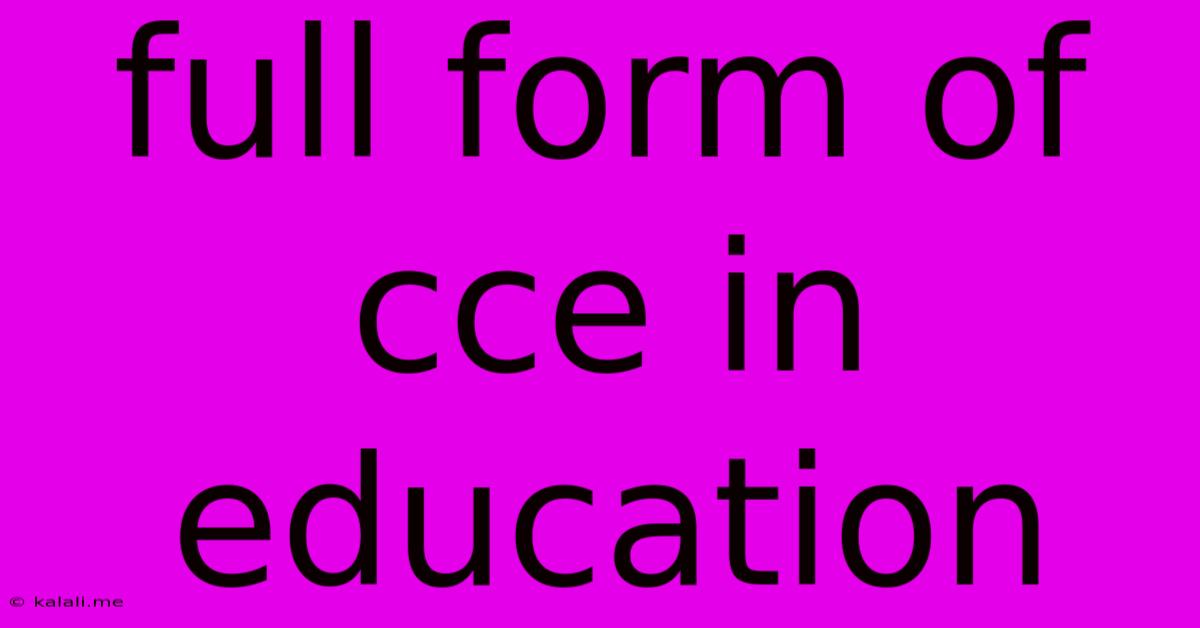Full Form Of Cce In Education
Kalali
Jun 13, 2025 · 3 min read

Table of Contents
The Full Form of CCE in Education: A Comprehensive Guide
Meta Description: Confused about the meaning of CCE in education? This article comprehensively explains the full form of CCE, its implementation, benefits, and criticisms, providing a clear understanding of this crucial educational approach.
The term "CCE" frequently appears in discussions about education systems, particularly in India. But what does CCE stand for, and what does it actually mean? This article dives deep into the full form of CCE in education, exploring its implications and impact on students and the educational landscape. The full form of CCE is Continuous and Comprehensive Evaluation.
Understanding Continuous and Comprehensive Evaluation (CCE)
CCE is a holistic approach to evaluating students' progress, moving beyond traditional, exam-centric assessment methods. It emphasizes continuous monitoring of a student's learning journey rather than relying solely on final examinations. The "continuous" aspect involves regular assessments throughout the academic year, while "comprehensive" highlights the evaluation of a student's overall development – academic, co-curricular, and personal.
This system aims to:
- Reduce exam stress: By regularly assessing students, the pressure of a single, high-stakes exam is significantly lessened.
- Provide timely feedback: Teachers can identify learning gaps early on and provide targeted support to students.
- Promote holistic development: CCE considers all aspects of a student's development, not just academic achievement. This includes skills like critical thinking, creativity, problem-solving, and teamwork.
- Encourage self-assessment: Students are actively involved in tracking their progress and identifying areas for improvement.
- Foster a positive learning environment: The focus shifts from competition to collaboration and individual growth.
Key Components of CCE
CCE typically involves a variety of assessment methods, including:
- Formative Assessments: These are ongoing assessments designed to monitor student progress and guide teaching. Examples include class tests, quizzes, assignments, projects, and observations.
- Summative Assessments: These assessments are conducted at the end of a unit or term to evaluate overall learning. Examples include term exams and final exams, though these often carry less weight than in traditional systems.
- Scholastic Area Assessments: These evaluate academic performance in various subjects.
- Co-scholastic Area Assessments: This crucial element assesses skills like work education, art education, health and physical education, and attitudes towards discipline. It promotes a well-rounded individual.
- Portfolio Assessment: Students maintain a portfolio showcasing their work, demonstrating their progress and skills over time.
Benefits of CCE
The implementation of CCE offers several significant advantages:
- Improved Learning Outcomes: Regular feedback and targeted support lead to better academic performance.
- Reduced Stress and Anxiety: The continuous assessment approach mitigates the pressure associated with high-stakes examinations.
- Holistic Development: CCE nurtures a student's overall growth, including personality, social skills, and extracurricular activities.
- Enhanced Teacher-Student Interaction: Continuous feedback fosters stronger teacher-student relationships and personalized learning experiences.
- Early Identification of Learning Difficulties: Regular assessments allow for early detection and remediation of learning challenges.
Criticisms of CCE
Despite its numerous benefits, CCE has faced certain criticisms:
- Increased Workload: Teachers may find the continuous assessment process demanding, requiring more time for planning, assessment, and feedback.
- Subjectivity in Assessment: Some assessment methods might be prone to subjective interpretation, potentially leading to inconsistencies in grading.
- Implementation Challenges: Successful implementation requires adequate teacher training, resources, and infrastructural support. Variations in implementation across schools can lead to inconsistencies.
- Focus on Grading: While aiming for holistic development, the system can sometimes still be overly focused on numerical grades, undermining its intended purpose.
Conclusion
Continuous and Comprehensive Evaluation represents a significant shift in educational assessment. While challenges remain in its consistent implementation and overcoming certain drawbacks, its focus on holistic development and reduced examination stress offers a more positive and effective learning experience for students. The success of CCE ultimately hinges on comprehensive teacher training, resource allocation, and a consistent approach across educational institutions. Understanding its full form – Continuous and Comprehensive Evaluation – is only the first step towards understanding its complex role in shaping the future of education.
Latest Posts
Latest Posts
-
Greatest Common Factor Of 56 And 84
Jun 14, 2025
-
Clutch Pack Limited Slip Differential Diagram
Jun 14, 2025
-
Average Gpa At University Of Toronto
Jun 14, 2025
-
Average Act Score For Ohio University
Jun 14, 2025
-
Acceleration Occurs When An Object Undergoes
Jun 14, 2025
Related Post
Thank you for visiting our website which covers about Full Form Of Cce In Education . We hope the information provided has been useful to you. Feel free to contact us if you have any questions or need further assistance. See you next time and don't miss to bookmark.